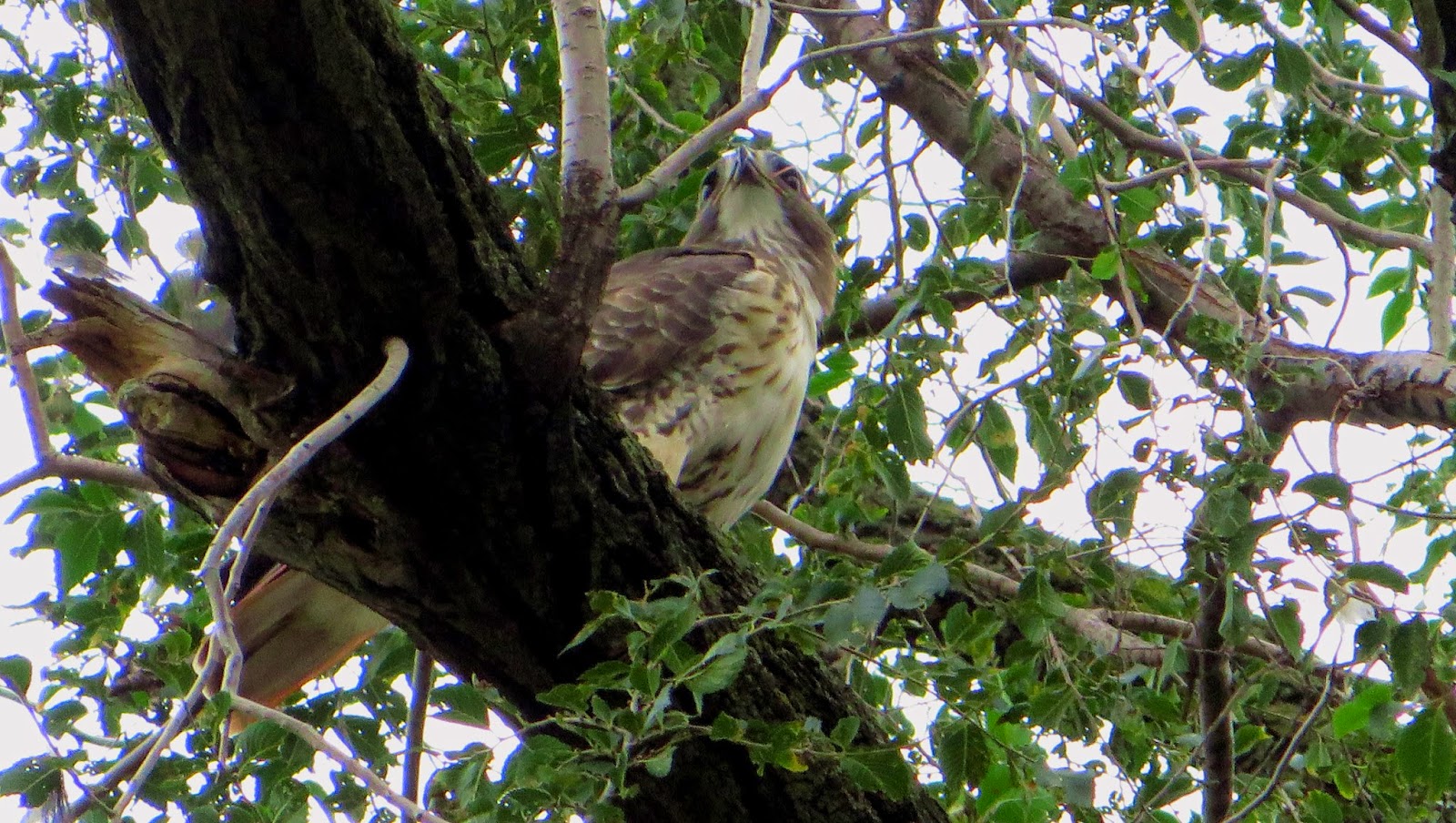Monday 27 October 2014
Today in Nature: The Fall Salmon Run up the Humber River
Wednesday 22 October 2014
Today in Nature: Fall Colours on Fire on the Humber River
Saturday 18 October 2014
Today in Nature: Alpha Males among the Wood Ducks
October 18th: These are wood ducks. The male is the colourful one at the top of the log, followed by his mate, and then a bunch of females, possibly daughters. Down at the bottom of the log there is a duck with an orange bill - that is a juvenile male. Next season he may grow his full colours and be ready to wow the females with his dashing good looks. For now, alpha male gets the best place on the log.
Thursday 16 October 2014
Today in Nature: Deer in Toronto
 |
| A White-Tailed Deer near the Humber River in Toronto |
 |
| A drowsy raccoon |
 |
| A Great Egret perching in a tree high above a pond. |
Tuesday 14 October 2014
Today in Nature: A Red Tailed Hawk at U of T
October 14th: I saw this red-tailed hawk today on the St George campus at U of T. It flew over the heads of hundreds of students at King's College Circle to land on a poor unsuspecting black squirrel. Life in the city is good if you have a taste for squirrel and pigeon. Since these prey species are all around all winter, red-tailed hawks often stay in the city all year.
 |
| Check out the paw and tail of the black squirrel dinner... |
Monday 13 October 2014
This day in Nature: The Glory of Fall
This Day in Nature: The Thanksgiving Chipmunk
October 13th: Stuffing your face on Thanksgiving dinner? So is this chipmunk. Its cheek pouches are filling up on goldenrod seeds. When the cheeks get full, it will head back to its underground burrow to deposit the seeds next to nuts it has been gathering. Like us, it makes the most of the fall harvest in preparation for the long winter ahead. Happy Thanksgiving, all!
Thursday 9 October 2014
Today in Nature: The Bird That Started the Study of Migrations
October 9th: This is an Eastern Phoebe. Like many birds, it is on the move, taking part in the fall migration. In fact, this species helped pioneer the study of bird migrations. In 1840, it was the first bird ever banded by John James Audubon, who wanted to study how birds migrated. To his delight, the banded Phoebes returned the next year. Today, banding helps scientists track the movements of hundreds of species. But you can also enjoy the migrations simply by looking up. I saw dozens of turkey vultures flying across the city today. Please feel free to share pictures and stories of any birds you see migrating.
Wednesday 8 October 2014
Today in Nature: A Migrating Catbird
October 7th: As fall gets serious, the birds are on the move. I came across this grey catbird at U of T today, where I rarely see anything but starlings, pigeons and sparrows. I suspect it is just passing through on its way to wintering grounds in the U.S.. It isn't alone - I haven't heard any redwing blackbirds lately, so they must have taken off for warmer climes, along with many of the other songbirds.
Monday 6 October 2014
Today in Nature: Milkweed takes Flight
October 6th: Just as the strong winds of fall begin to blow, this milkweed plant is getting ready to hitch a ride. The pods have opened, revealing up to 100 brown seeds, each one connected to a silky parachute. The design is ingenious - some seeds will fly many acres away. The seeds are the plant's future, and key to the destiny of monarch butterflies, too. These are the only plants they will lay eggs on, so a good crop of milkweed is also good for insuring the survival of these beautiful butterflies.
Sunday 5 October 2014
Today in Nature: Let the Dreaming begin!
October 5th: A friend of mine recently remarked that she doesn't like fall since it is ultimately about decay. I prefer to see fall as a kind of extended bedtime. The deciduous trees will spend the winter asleep, so this is their period ofdrowsiness, when they get undressed before going to bed. But unlike us humans, the amazing dream visions happen before they fall asleep, and are now on view for all to enjoy. If we must lose the leaves for a while, what a beautiful way to do it....
Thursday 2 October 2014
Today in Nature: The Picture that may save your life
October 2nd: This picture may save your life some day. These fungi grow on Birch trees, and are known all over the world as 'tinder' fungus. The flesh inside these hoof-shaped fungi can be used to light a fire, and carry it for long distances because it burns so slowly. Also, if you boil it in urine for a few days ( who figures this stuff out?), it becomes an excellent material for starting fires since it is very flammable. Otzi, the 5000 year old Ice Man who was found in the Alps some years ago, was carrying chunks of this fungus, along with flints for creating sparks. So if you're ever lost in the woods, and need to keep a fire going, look for this stuff.
Subscribe to:
Posts (Atom)














